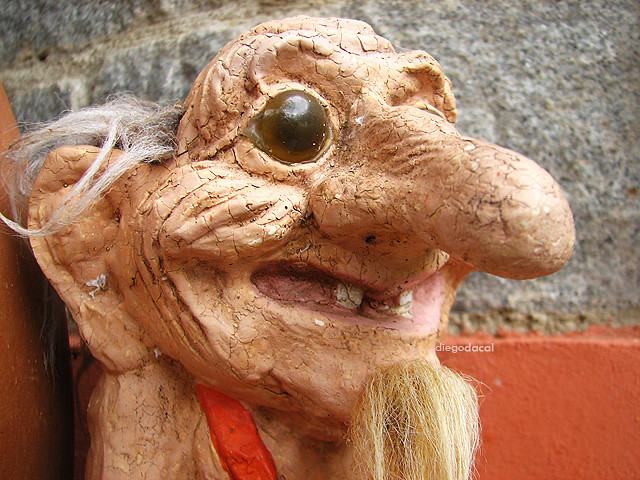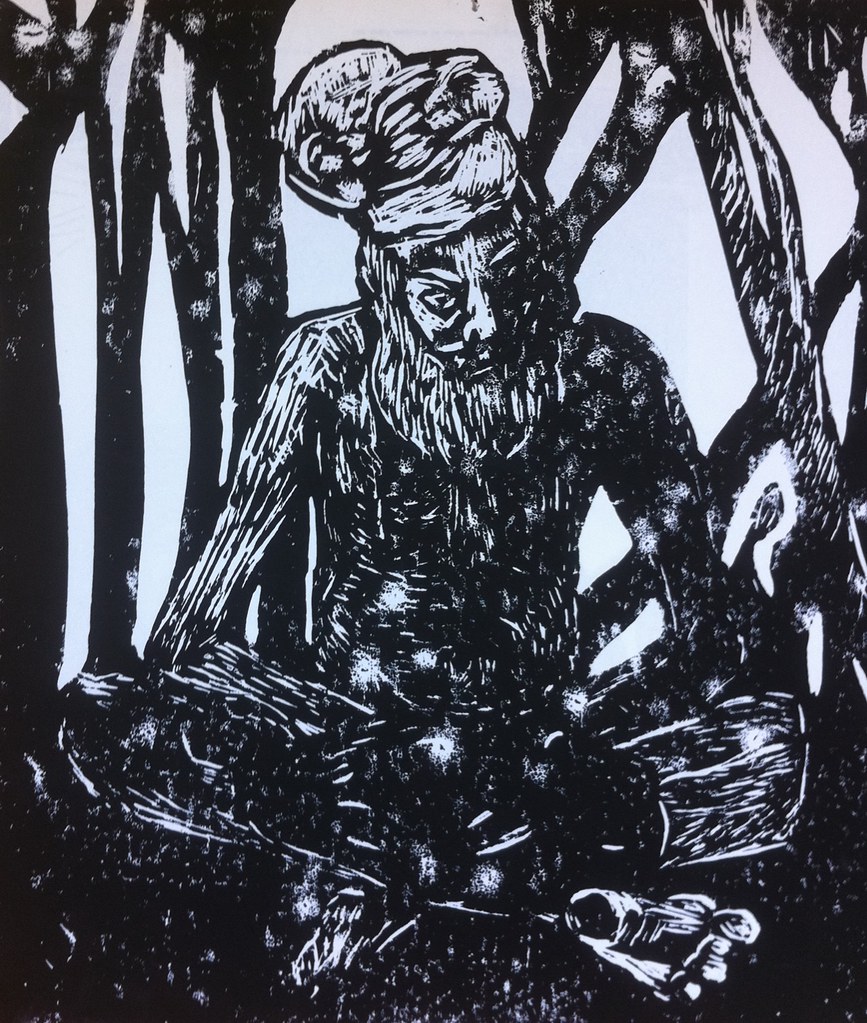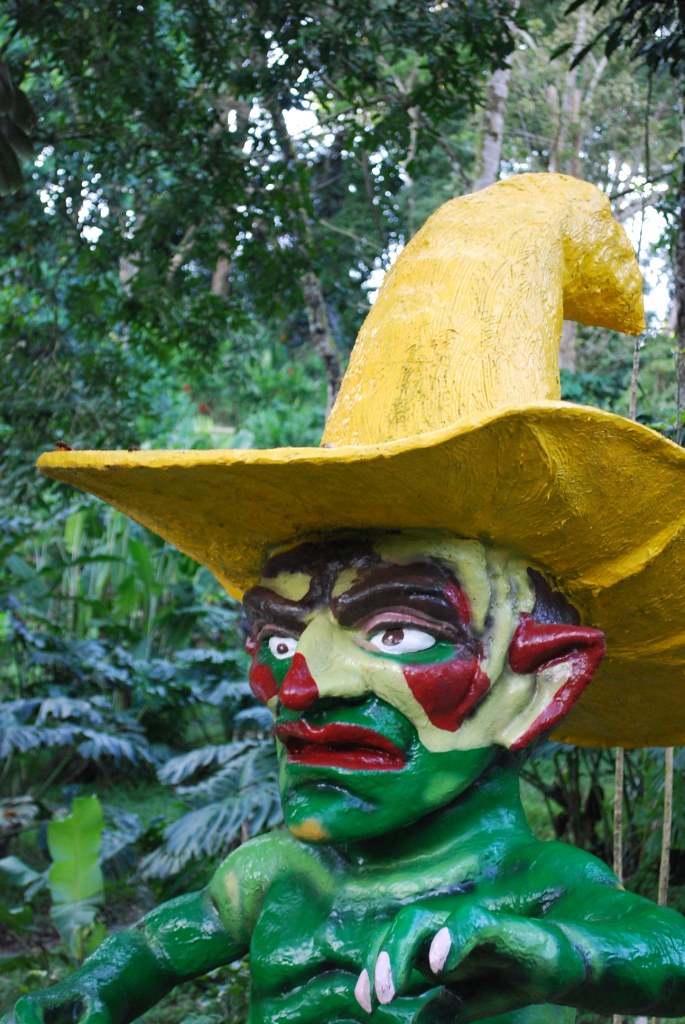According to Philippine lore, mounds of soil or anthills are not just nests for insects like termites and ants. The majority of us who grew up in the Philippine provinces knew why our elders instructed us always to excuse ourselves (thus the term “tabi tabi po” became a common phrase in our country) whenever we are passing by this soil formation, or even in secluded areas where trees and shadows create a mystical ambiance. The inhabitants of these mounds were also believed to be the same reason your playmate was suddenly afflicted by fever or inflammation. It is not uncommon to see platters of food offered for these unseen malady giver.

License: https://creativecommons.org/licenses/by-sa/2.0/
Duwendes from Philippine folklore are so familiar in our memory that it can still incite both fear and mystery whenever the subject is broached. Commonly described as an old man or ‘nuno’ with the height of a small child dwelling beneath the earth (thus the term “nuno sa punso”), these creatures hold more than just simple tales to scare and make the young ones behave. What could be more intriguing (or terrifying) than finding out that there are several kinds of Duwende here in the Philippines and that they can be a good, generous friend or a vengeful foe?
OLD MAN WITH A CHILD’S BODY
The late Dr. Maximo Ramos, one of the early scholars who created a compendium of lower mythological creatures of the Philippines, describe Dwarves or Duwende as a “spirit of the fields”, “spirit of the hills” and “people of the ground.” Despite their size, Duwendes are depicted with large features such as their eyes, nose, mouth and even their hands and feet. Their features greatly resemble the Scandivian and Germanic conception of dwarves ,which are human like and yet portrayed as small and ugly. This is somewhat parallel to the description made by Emeterio C. Cruz in his article for Philippine Magazine XIXX (January 1933) where they were described as small humanoid beings with one eye in the middle of the forehead and large nose with a single nostril. Nonetheless, the typical image of Duwende is often a an old man with a body the size of a child and wearing a salakot (a native hat usually worn by farmers).
Underneath the anthill where they live are said to be countless collections of precious gems and gold which they keep for themselves. On occasion they share or promise some of it for the maiden they are trying to court – commonly with beautiful names or those who love to sing while cooking according to some tales. In other stories, they offer it to those they deem as friends. The Sagay who is known as the dwarf like being from Surigao, does not dwell in anthills, but in mines where it owns golds and will only exchange it for the blood of children.
Duwendes are known mainly for they magical ability to make someone who hurt or offended them to suffer with unusual diseases ranging from skin rashes, inflammations and fevers that can’t be cured by any medical interventions. As mentioned above, Duwende also bring enchanted gifts to their mortal friends. in Ilocano folklore, the Kibaan (as big as a child, fair skin, long nose, slant eyes, long hair that reaches down their feet – the toes of which point backward) brought a coat that could make someone invincible and a kiraod, a kind of dipper that when place inside an empty jar can produce rice. The Lampong from Ilongot beliefs has the ability to transform into a white deer with one single bright eye on its forehead and it is quite well known by hunters as the protector of wild life in the forest.
Even though Duwendes might not be welcomed by people, most of them live near communities or villages. In other cases they actually dwell in people’s homes – although are rarely seen or noticed by the owner of the house. This also explains why the Spanish were quick to apply their own blanket term to these beings, “duende” – contraction of duen de casa, from dueño de casa ‘owner of the house’.

License: https://creativecommons.org/licenses/by/2.0/
SPIRITS OF THE EARTH
The Duwende’s affiliation to the element of the earth sprang from the fact that their abode comes in the form of ground or land formations. Jaime Licauco, in his book “Dwarves and Other Nature Spirit: Their Importance to Man” links the Duwende and Dwarves to the classification made by the Swiss philosopher, mystic and physician Paracelsus. In his work, he explained that the elements fire, water, air and earth are manifested via nature spirits or elementals that dwell among us. The reason why they can’t be seen is because their flesh did not originate from Adam. The flesh of elementals or nature spirits is composed only of one element but they don’t have a soul like people. For example, fire elementals are called Salamander and as their element affinity states, they are all made by fire. Earth elementals are called Gnome and are closely related to the Dwarves and Duwende from our folklore and mythology. Gnomes are also earth dwellers and usually serve as the guardian of different land formations such as mines and are known for being a hoarders of golds, gems and precious stones. They are not accustom to interacting with humans and since they are made from earth, they can actually travel under the ground with ease.
In similar fashion, Duwendes in folklore are also identified as guardians, protectors and at times the true owner of land – particularly fields that are used for planting rice. An example of a duwende as the “landlord” is the Karanget known also known to the Ifugao as the ‘louse of the earth’ (kutong-lupa). Farmers make offerings to this Duwende in the form of boiled rice, unsalted boiled chicken and cigars. These offerings are left in the rice field after sun set and is usually done again before plowing the land. To make them take care of the plants, farmers also sprinkle the blood of a red rooster on the leaves of the young plants.
The Ilokano Ansisit on the other hand has a rather old fashioned preference when it comes to the land they own; they prefer the farmers to plow it with their Carabao instead of a tractor for fear that the machine might destroy its home.
FRIEND OR FOE?
According to our elders, Duwedes are also capable of doing extreme acts of goodness. In rural areas there are stories that state if you manage to befriend a Duwende, you can expect to have a successful life. Your earth spirit friend will bring good fortune and can give money, food and even precious gems or magical items. However, their is a belief that one must spend or consume immediately what the Duwende gives or it will vanish immediately. One must also take note that forging a friendship with a Duwende is for a lifetime and breaking the bondwill not just bring bad luck but even death.
But, as everything needs an opposite, there are also the evil and dreaded Itim na Duwende or Black Dwarves that notoriously inflict harm towards people. Besides the mysterious malady they give, they are extremely crafty tricksters who target young maidens and children. As revenge for disrespecting them, they often resort to kidnapping the child or a female relative from the offender. Most of their victims are carried to their domicile and promised all the things they want in exchange for staying with the Duwende for the rest of their lives. In other lore, an Ugaw from Pangasinan is a small being that looks like a doll and is often known to steal rice from houses or granaries. Because they are usually unseen, they can manage to follow people without being noticed.
Although the majority of popular media has put the Tianak under a category of flesh eaters, Maximo Ramos placed them within the category of a Dwarves since they have the common qualities of an older being with a child’s body. The tales surrounding the Tianak often depict it as a monstrous child similar with how it was shown in Peque Gallaga & Lore Reyes’ 1988 horror film “Tiyanak”. Yet in other alternative tales, the Tianak is somewhat fond of tricking instead of eating those who thought they were just a lost baby beneath a tree. Under the guise of a charming child with the slight defect of having one of its legs smaller than the other, it can beguile anyone who hears its cry. Once it is pick up, it will transform into an old man to scare you away while it laughs out loud for successfully fooling you.

License: https://creativecommons.org/licenses/by/2.0/
WHERE IS OUR “DUWENDE” TODAY?
A Spanish poet that goes by the name of Francisco Garcia Lorca once wrote about the concept of the Duende deep within the soul of an artist. This as he explained is the same concept of the muse of the poet who inspires heightened moments of creativity. Perhaps the current resurgence and popularity of Philippine Mythology is due to artists and storytellers activating their inner duwende, or perhaps the duwende is activating them. I am just so glad that through the creative forces of every Filipino artist and writer, our own folktales and mythology will continue being passed down to the next generations. Perhaps the Duwende for our childhood imaginations will appreciate the fact that they are remembered on canvass, in books and even in music; a fitting tribute for our ‘Nuno’.
Source:
The Creatures of of the Philippine Lower Mythology by Maximo D. Ramos (1990)
The Creatures of Midnight by Maximo D. Ramos (1990)
The Lost Journal of Alejandro Pardo: Creatue and Beast of Philippine Folklore by Budjette Tan, Kajo Baldisimo, David Hontiveros, Bow Guerrero and Mervin Malonzo (2016)
Philippine Ogres and Fairies by Emerito Cruz from Philippine Magazine XXIX (1933)
Dwarves and Other Nature Spirits: Their Importance to Man by Jaime T. Licauco
Mythmuseum.weebly.com
ALSO READ: FOLKLORIC SPIRITS: Is Knowing “Tabi Tabi Po” Enough When Travelling the Philippines?
Currently collecting books (fiction and non-fiction) involving Philippine mythology and folklore. His favorite lower mythological creature is the Bakunawa because he too is curious what the moon or sun taste like.


